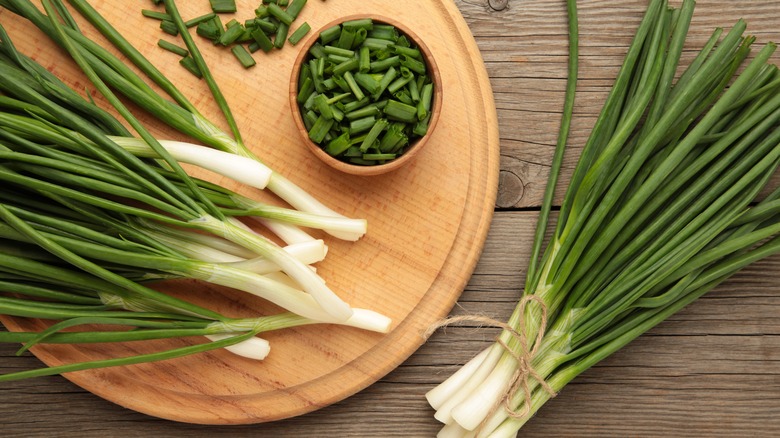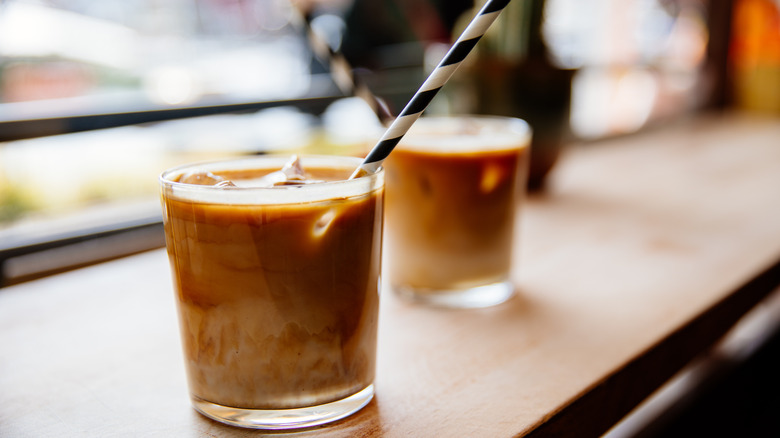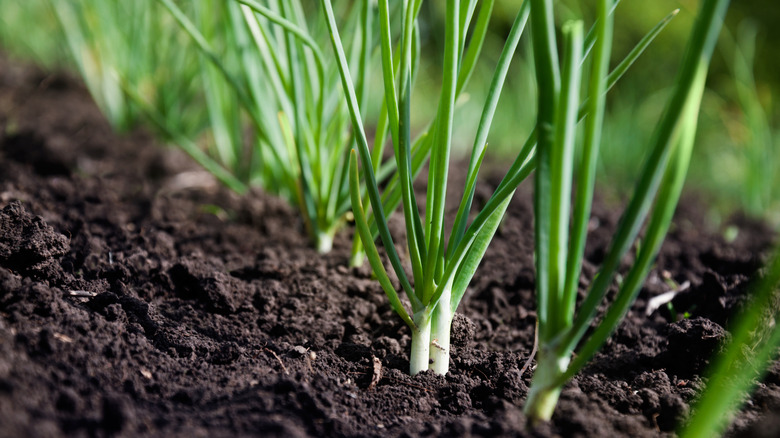Green Onion Coffee Is All The Rage In China. Is It Worth Trying?
You can tell a lot about a person from their coffee order. Someone who orders it black may be more practical and straightforward, while someone who loads up their cup of joe with cream and sugar may be more of a child at heart. Some people have dedicated their lives to brewing the perfect cup of coffee, like the countless coffee lovers that participate in worldwide barista competitions every year. Baristas from the United States have harnessed different flavors like lemon, rose, and coffee flower to brew exciting and innovative beverages. And while this java is certainly creative, when it comes to sheer inventiveness, there's no beating the flavor combinations coming out of China. For example, the current biggest coffee trend is an iced latte mixed and topped with scallions, or green onions.
China is certainly no stranger to genre-defying flavor combos. Earlier this year, Starbucks introduced savory pork breast lattes in China. The green onion latte may not be as packed with protein, but what it lacks in sustenance it makes up in pungent flavor. If you want to try it yourself, start by loading your coffee cup with a handful of chopped green onions. Next, pour in the typical latte ingredients (ice, milk, and espresso) before using more scallions to garnish.
Scallion lattes are part of China's 'dark cuisine' trend
This isn't a recipe with any practical applications, such as this one for coffee with baking soda that'll soothe your stomach. Nor is it a drink developed from necessity, like these strange foods eaten during the Great Depression. Instead, green onion lattes and similar interesting recipes are all part of China's "hei an liao li" trend, which means "dark cuisine." As Jenny Gao, a chef born in China, explained to the New York Times, dark cuisine "can refer to anything that's particularly hard to swallow," like food made in less than sanitary conditions, "amateur disasters," and "deliberately made creative food that's unexpected." Green onion lattes would fall firmly into the third category, along with trends like adding cheese and basil to your java, or drinking it out of a hollowed-out pepper.
However, just because a drink is unique, it doesn't mean it's a gustatory success. Though there are some people who appreciate the combo, like the Instagram user who commented, "better than coriander at least," overall, people seem quite disgusted by the latte. Even though the reception for the latte has been mostly negative, it has still generated buzz for the cafés that sell it. In a world where chain coffee shops seem to be taking over, implementing dark cuisine is a way for smaller businesses to keep an edge in the industry.
More examples of dark cuisine
Green onion and even pork belly lattes are far from the most extreme examples of dark cuisine. There are other espresso drinks that really push culinary boundaries. In the southeastern city of Zhangzhou, for example, baristas fill coffee cups with mustard, soy sauce, and octopus. To the east in Xiamen, coffee shops encourage customers to dunk beef meatballs and chili noodles into their coffee orders. Over the past few decades, coffee has become very trendy in China. The aesthetics of coffee are a big component of that popularity, so through that lens, coffee cups filled with different, unexpected ingredients (like produce, protein, and more) would certainly make an impression.
Outside of coffee, dark cuisine has had an impact on all sorts of recipes. From kiwi omelets to soups made of cotton candy and gravy, both professional and amateur chefs have found a lot of fun and creativity in this trend. It's theorized that dark cuisine was developed as a way to subtly rebel against the rather restrictive Chinese government, and in that regard, it's a great example of the relationship between cooking and art. And it's actually spawned some yummy ideas, like topping ice cream with chili oil. At the end of the day, taste is subjective, so the only way to know if a scallion latte is actually worth drinking is to try it yourself. Who knows, it may propel you on your own dark cuisine journey.


